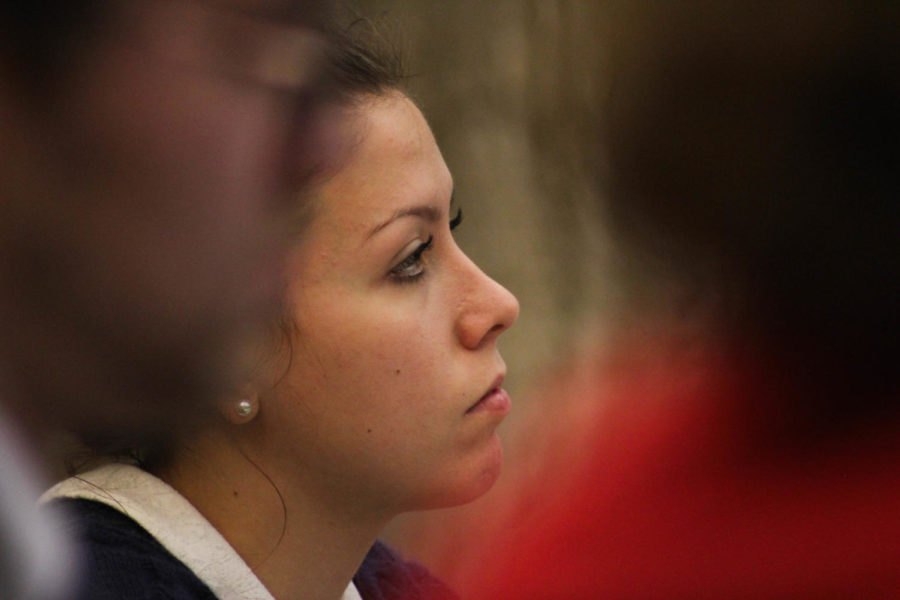He speaks, she speaks: A semester of senate
November 30, 2017
As an elected body, Student Government is not immune to gender disparities.
In an analysis of the 14 Senate meetings this fall that measured the amount of times voting-members spoke, the Daily found that despite there being almost as many women on the Senate as men, 16 to 19, male senators spoke at a much higher rate than that of their female counterparts.
At one meeting, for instance, men comprised 52 percent of the Senate yet spoke 82 percent of the time — a trend consistent throughout several other Senate meetings during the semester.
Additionally, the Daily found that while speaking privileges among the male senators were more evenly dispersed, it was the same women — who were also more veteran senators and often in a leadership position — that routinely spoke at each meeting.
However, the analysis does not take into consideration the length of the speaking privileges nor the substance of what was said within that period, or the work senators have done within the committees they are a part of.
Speaker Zoey Shipley, who has been involved with the Senate for the past two years, said she wasn’t surprised by the percentage of times men spoke compared to women.
“That’s why I’ve stressed speaking to female senators and to try to create a group environment for women to come together and talk more. I have seen it as a huge issue,” Shipley said. “It does reflect a lot of what I expected for the semester.”
Addressing diversity and inclusion has been an ongoing effort within Student Government and campus as a whole.
Last year, there were only seven female senators out of 34 in total. After the March elections, 13 female senators were elected out of 37 in total. However, with some senators resigning over the summer, the number of women dwindled to nine at the first Senate meeting.
Over the course of the fall session, seven female senators were seated to Student Government bringing the total number of women to 16.
“A huge advantage for women, specifically last year, was that there were a lot of senior members who had more experience on Student Government,” Shipley said. “I don’t know if women spoke more than they are speaking now, but there might have been a little bit more speaking by women because there were more senior members.
“We lost a lot of great voices last year.”
Shipley, due to her role as speaker and experience as a seasoned senator, spoke at every Senate meeting that she was in attendance and oftentimes spoke more than any of her female colleagues.
At a Senate meeting toward the beginning of the semester, Shipley spoke five times. Only two other female senators spoke at that meeting and they did it just once each. As more Senate meetings passed, however, more women began to speak more frequently.
At a meeting in late September, women made up 46 percent of the Senate and spoke 36 percent of the time — the highest percentage of the session.
Shipley attributed some of the hesitance on the female senators behalf to speak during meetings to the topic of debate, such as finance.
“I don’t talk a lot during the finance bills unless it is making sure that the student groups are prepared and represented,” Shipley said.
Student Government authored 76 pieces of legislation this fall with 34 bills relating directly to finance. Of the 36 finance bills, 34 were authored by men.
The finance legislation authored by women related to internal Student Government matters such as funding food for its town hall or posters relating to addressing sexual violence.
Many speaking privileges granted to men were due to the sheer fact that they authored the legislation and were asked questions regarding the bill.
“I think it comes off [Senate] as sometimes a ‘Boys Club’ and specifically a white boys club. Half of our chief officers are white males named ‘Cody.’ That speaks volumes,” said vice speaker Cody Woodruff. “We have to be conscious of that fact.”
However, Shipley and Woodruff are optimistic of what next semester may bring — a more representative Senate and more experienced senators.
“I don’t have a solution. It’s just continuing to try, and hopefully — here on campus and in society — we can start to break down those barriers. We are seeing that slowly but surely. It’s too big of an issue for [the] Iowa State Student Government to solve,” Woodruff said.
Dianne Bystrom, director of the Carrie Chapman Catt Center for Women and Politics, said that at almost every level of government the first step toward a more equitable and representative governmental body is getting more women to run for office. It begins, she said, by simply asking.
“The big thing for women at Iowa State that I see, and I see in women in general, is that they don’t run for office. The biggest thing is encouraging women to run — and I think that does need to be peer-to-peer,” Bystrom said.
For Shipley, however, she knows firsthand how intimidating it may seem to run for political office — as she, too, had to be asked to run for speaker.
“I think there is always going to be that back of the mind voice telling women that they cannot run because of what is happening in society, so until there is a huge societal change — I think women are always going to have that voice … saying ‘I don’t think so’ or ‘That doesn’t sound like something for me,’” Shipley said.
She’s excited, however, for the continued progress she sees Student Government making.
“How much you speak at Senate does not determine how good of a senator you are,” Shipley said.







